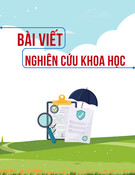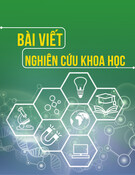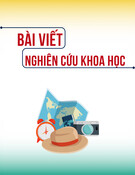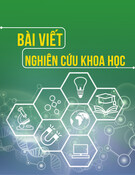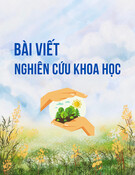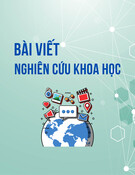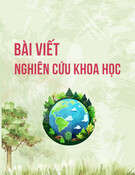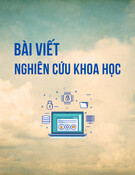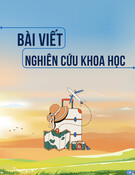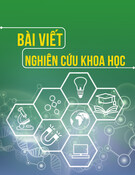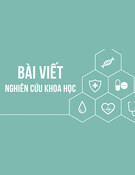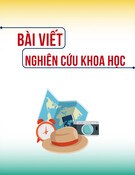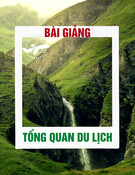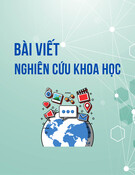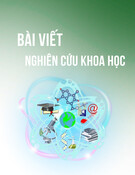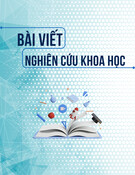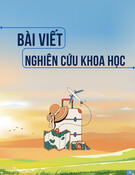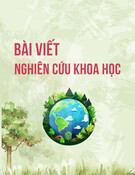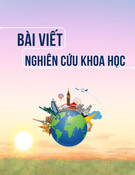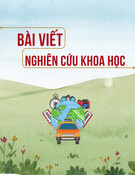
113
Sè §ÆC BIÖT / 2024
Summary
Through applying conventional research methodologies in physical education and sports, this study
has developed a systematic digital transformation process, accompanied by four digital product sets
demonstrating significant positive effects on 7-year-old blind and visually impaired children. Empirical
trials have validated the efficacy of 66 digital-transformed exercises. Among these innovations, the
newly developed "Training for the Blind" application stands out as it successfully meets the training
needs and fosters enthusiasm among participants, while also accelerating the community reintegration
process for blind and visually impaired children.
Keywords: blind and visually impaired children, blindness, severe visual impairment, SOS
Children's Village Hanoi.
(1))PhD, Bac Ninh Sposst University; (2)Master, Vietnam Youth Academy
(3)Master, Personnel Organization Department, Hanoi City Police
(4)BA, Fitness Life Vietnam Joint Stock Company; (5)BA, Phu Hung Sports LLC
Nguyen Huu Hung(1); Nguyen Thi Luu(2)
Nguyen Duy Thanh(3); Nguyen Thi Tham(4); Le Trung Kien(5)
INTRODUCTION
In Vietnam, blind individuals make up a
significant portion of the disabled population,
with children being a particularly vulnerable
group that requires greater societal attention.
The rapid progression of digital transformation
in recent years has had a profound influence
across all sectors, including sports, which is
increasingly adapting to align with these
technological advancements. We are now in an
era of extensive digital integration, making the
application of digital technologies to physical
exercise programs for blind and visually
impaired children both timely and essential.
These interventions are designed to improve
reflexive abilities and spatial awareness, aiding
in the early reintegration of blind and visually
impaired children into society. However, this
sector remains limited in Vietnam.
Consequently, selecting digital-transformed
exercises, which enhance the reflexes and
spatial awareness of children living at the SOS
Children Village in Hanoi, plays an important
role to the weak in society. Therefore, it boosts
the process of reintegrating into the normal
society of blind and visually impaired children.
RESEARCH METHODS
This study employed a comprehensive array
of research methods, including Document
Analysis and Synthesis, Pedagogical
Observation, Interview Method, Expert
Consultation, Pedagogical Experiment,
Pedagogical Testing, and Statistical Analysis.
RESULTS AND DISCUSSION
Through various research methods, the study
selected 66 out of 68 exercises, categorized into
four groups: Basic warm-up exercises group (3
exercises), Exercises to enhance reflexive
abilities group (29 exercises), Exercises to
improve spatial awareness group (27 exercises),
Cool-down exercises group (7 exercises)
The process of digital transformation for
exercises to enhance reflexive abilities and
spatial awareness for blind and visually
impaired children at the SOS Children's Village
is illustrated in Diagram 1. The results of
interviews about selecting digital technologies
for these exercises are presented in Table 1.
The data presented in Table 1 indicates a
strong consensus among experts regarding the
selection of three technological tools, with total
scores ranging from 58 to 66 points. The
DIGITAL TRANSFORMATION OF PHYSICAL EXERCISES
TO ENHANCE REFLEXES AND SPATIAL AWARENESS FOR BLIND
AND VISUALLY IMPAIRED CHILDREN

p-ISSN 1859-4417 e-ISSN 3030-4822
114
Diagram 1. Process of digital transformation for exercises to enhance reflexive abilities
and spatial awareness for blind and visually impaired children
average Likert values (on a 3-point scale) were
between 2.94 and 3.0. These results confirm the
validity of the established processes and provide
a basis for implementing the subsequent steps
to digitize exercises aimed at enhancing
reflexive abilities and spatial awareness for
blind and visually impaired children at the SOS
Children's Village in Hanoi and surrounding
facilities in Hanoi and Bac Ninh. At the same
time, experts unanimously emphasized the
attention to the newly programmed
technological product, which applies digital
transformation: the app Training for the Blind.
The established process for using the Training
for the Blind app is as follows:
- Step 1 (with assistance): Download the
"Training for the Blind" app and install the
software on the device. Make sure to select the
appropriate platform (iOS or Android) based on
the device being used.
- Step 2 (with assistance): Open the software
on the installed device.
+ Option 1: A volunteer assists in entering the
child’s information into the app in text form.
+ Option 2: A volunteer lets the child enter
information into the app by saying the
information.
- Step 3 (with or without assistance):
Implement the lesson plan using the digitized
voice exercises that the app's artificial
intelligence platform has set up for training. In
the initial training stages, children will require
assistance to help them understand reflexive
responses and basic exercise routines, which
will take about two lesson plans. Afterward,
children can practice independently at this stage.
The app allows adjustments to the reading speed
- either faster or slower - and enables users to
return to previous lesson plans if training
outcomes are unsatisfactory; however, lesson
plans cannot be accessed out of order, as this
would cause the app to malfunction.
- Step 4 (with or without assistance): Exit the
software by pressing the “stop” button, pressing
“Back” twice, or using the power button to exit.
• Note: After Step 4, the volunteer can record
training information, noting strengths and
weaknesses, as well as evaluating the lesson
plan. If the child practices independently, they
should describe their personal feelings and the
degree of adherence to the lesson plan to the
volunteer to collaboratively find appropriate
solutions for the next lesson.
The experimental organization process lasted
for three months, with 2 to 4 sessions each week
(not including additional voluntary practice
time). The experimental subjects consisted of
120 blind and visually impaired children, both
male and female, aged 7, from 9 clubs, special
schools, and care centers for blind and visually
impaired children located in Hanoi and Bac
Ninh. The results were recorded before the
experiment and after three months of practice
through selected tests. The results are presented
in Figure 1, Table 2, and Diagram 2.
The results in Table 2 indicate that both the
experimental and control groups of 7-year-old
children, regardless of gender, showed
significant differences in most tests, with t-
calculated exceeding the t-table at a probability
level of P < 0.05. This demonstrates that the
implementation of the selected digitized
exercise programs positively impacts the
development of reflex and spatial awareness
skills in blind and visually impaired children at
the SOS Children's Village in Hanoi and nearby
facilities in Hanoi and Bac Ninh. However, in
the group of Girls Aged 7 – Visually Impaired,
Step 1 Step 2 Step 3 Step 4 Step 5
Situation assessment
and planning
Strategy
development
Data and process
digitization
Organizational
preparation
Evaluation and
improvement

115
Sè §ÆC BIÖT / 2024
No. Content Total
points Likert
1
Big Data Application (Online Storage Application):
58 2.94
Advantages: Offer a free sponsorship to the project for research
implementation with a total upload capacity of 120GB, valid for 2 years
(valued at 3,500,000 VND per year)
2
Vbee AI Voice Studio (Artificial Intelligence Voice Application):
66 3
*Advantages:Free text-to-voice conversion for the project with a total
upload capacity of 10,000 documents, expanded storage for voice files in
MP3 format, valid for 1 year.
- Hình ảnh logo:
3
Developing Open-Source Code and Creating an App (Mobile Appli-
cation for iOS and Android Platforms):
66 3
- Logo Design Concept:
+ The stylized letter "S" represents the shape of Vietnam and forms an eye.
+ Three white dots in different colors represent the three regions
of Vietnam, symbolizing the blind.
- The colors gray, yellow, and
green represent mountains, plains,
and seas. Green symbolizes hope;
orange signifies determination to
overcome personal challenges; and
gray represents resilience and the
drive to progress with the nation.
- App Logo Name: Training for the Blind
-*Advantages:
+The app is newly developed, free, and can store data in text or voice for-
mat (MP3). It functions both offline and online, supporting users with op-
erations akin to Artificial Intelligence.
Table 1. Interview Results on Selecting Technologies for Digitizing Exercises
to Enhance Reflexive Abilities and Spatial Awareness for Blind Children (n=22)
Logo image

p-ISSN 1859-4417 e-ISSN 3030-4822
116
Figure 1. Process for downloading the app/installation/inputting information data and
practicing reflex and spatial awareness skills for blind and visually impaired children
Table 2. Comparison of results from the use of digitized exercise programs through
assessment tests for enhancing reflex and spatial awareness skills in 7-year-old blind
and visually impaired girls (n=120)
No Tests
Comparison of Results between Control and Experimental Groups
Girls Aged 7 (n=60) – Blind Girls Aged 7 (n=60) – Visually
Impaired
Control
Group
(n=30)
Experimental
Group
(n=30))
t P
Control
Group
(n=30)
Experimental
Group
(n=30)
t P
1Identify Sound
Signals (s) 18.0 ± 1.14 17.88± 1.11 2.51 <0.05 17.9 ±1.03 15.6 ±1.07 2.51 <0.05
2
Identify Reflex
Signal in Four
Directions
(points)
7.2 ±0.42 7.9 ± 0.37 2.39 <0.05 7.5 ±0.37 7.8 ±0.33 1.11 >0.05
3Follow a
Straight Line
(cm) 166 ±2.50 148 ±2.44 3.38 <0.05 145 ±2.50 125 ±2.60 2.42 <0.05
4
Determine
Hand Angle
(degrees)
44.0 ± 1.19 36.5 ±1.54 2.37 <0.05 43.01 ±1.19 35.1 ±1.29 2.49 <0.05
5
Determine
Body Angle
(degrees)
47.01 ±1.66 41.05 ±1.68 2.34 <0.05 46.04 ±1.50 45.1 ±1.74 1.6 >0.05
6
Evaluate
Interest Level
in Participating
and Practicing
Digital Exercise
Programs
(points)
5.5 ±0.62 8.19 ±0.41 2.36 <0.05 7.78 ±0.35 9.8 ±0.24 6.38 <0.05

117
Sè §ÆC BIÖT / 2024
there were still two tests where, despite the
experimental group's mean values being higher
than those of the control group, they did not
show statistically significant differences at the
probability level of P > 0.05.
CONCLUSION
The research process has established a digital
transformation process, along with four digital
product sets that have a positive impact on 7-
year-old blind and visually impaired children,
including those who are totally blind. The
practical application results have proven the
effectiveness of the 66 digitized exercise
programs, comprising 120 specific training
lesson plans for four target groups. Notably, the
newly created product, the app "Training for the
Blind," has met the needs and interests of
participants, facilitating the reintegration
process into the community for blind and
visually impaired children.
REFERENCES
1. Dinh Nam (2021), The pioneer
responsibility in digital transformation,
Baochinhphu.vn.
2. Phạm Minh Mục & Trần Thu Giang
(2012), Developing communication for multi-
disabled blind and visually impaired children,
Education and Science journal, no. 80, p. 43-46.
3. Trịnh Thị Thu Thanh (2022), An overview
of education for multi-disable blind and visually
impaired children in Vietnam and in the world,
Science journal – Vietnam Institute of Science
and Education.
4. Sacks, S. Z., & Silberman, R. K. (1998),
Educating students who have visual
impairments with other disabilities, Paul H.
Brookes Publishing Co., PO Box 10624,
Baltimore, MD 21285-0624; World Wide Web:
http://www.pbrookes.com.
5. Parker AT & Pogrund RL (2009), A review
of research on the literacy of students with
visual impairments and additional disabilities,
Journal of Visual Impairment & Blindness, p.
635-48.
(Received 25/8/2024, Reviewed 4/10/2024,
Accepted 28/11/2024
Main responsible: Nguyen Huu Hung
Email: huuhung2710@gmail.com)
Diagram 2. Advantages of digitized exercise programs for enhancing reflex and spatial
awareness skills in blind and visually impared children
Diagram 4:
Digital
conversion
products for
exercises for
blind and
visually
impaired
children aged
7 & 8
1) Lesson preparation, selection, and detailed observation of each exercise, then
describing it in digital text file format:
*Advantages: No need for speakers or headphones, helping volunteers have a
system of text-based exercises for reference, reading, and guiding the
participants to ensure expertise.
2) Converting text files into voice files, in MP3 format with 66 exercises:
*Advantages: Volunteers do not need to read the text; they can actively and
adaptively play the MP3 files (these files are suitable for children who have
developed basic motor skills).
3) Set of 8 offline data files, including 240 exercise methods aimed at specific
condition of different visually impaired participants:
*Advantages: Files are arranged according to training programs that are
recommended by experts, and follow AI-approached orientation.
4) Brand-new software: app named “Training for the Blind” (includes the full
set of products in items 1, 2, and 3):
*Advantages: Smart, easy access (only requires internet and a smart device).

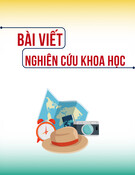
![Đề cương ôn tập Bản đồ du lịch [năm hiện tại]](https://cdn.tailieu.vn/images/document/thumbnail/2025/20250809/dlam2820@gmail.com/135x160/53061754884441.jpg)
